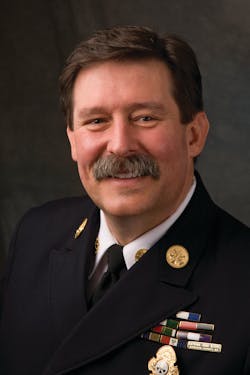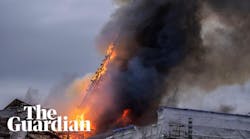The development of low-cost, high-quality drones together with lightweight, high-quality digital cameras offers emergency responders and fire buffs a tremendous opportunity to gain previously impossible perspectives of emergency incidents. There are a number laws and legal theories that apply to drones, including trespass law, invasion of privacy and negligence. In addition, federal, state and local laws govern to varying degrees the operation of drones.
What is a drone?
One of the initial challenges we face is agreeing upon a definition of a drone. Essentially we are talking about an unmanned remotely controlled aircraft. A variety of names have been used including unmanned aircraft (UA), remotely operated aircraft (ROA), remotely piloted vehicle (RPV) and unmanned aerial vehicle (UAV). The Federal Aviation Administration (FAA) has now settled upon the term unmanned aircraft system (UAS), which acknowledges that drones include not only an aircraft, but a piloting control device and a method of communications between the two…well…most of the time. There are UAVs that are capable of being operated completely robotically through software without external guidance. Do you start to see the complexity of the problem?
The FAA definition of a UAS includes larger aircraft such as the military’s Predator drone, but also includes smaller recreational craft that FAA regulations refer to as “model aircraft.” The law applicable to drones is evolving as it struggles to keep pace with the technology. The FAA hopes to have regulations in place later this year for small UAS, under 55 pounds that are used within visual line of sight (VLOS)
1. Trespass law
The origins of Anglo-American property law predate manned aircraft, let alone unmanned drones. The development and proliferation of aircraft in the early 1900s caused a number of previously established legal principles to be reconsidered.
At one time, a property owner was said to own the air over the property “up to the moon.” Someone who threw a rock or shot a bullet across another’s property committed a trespass. In essence a trespass is an unlawful intrusion upon the property of another without permission or justification. Trespassing is a crime and can be grounds for a civil suit.
As trespass law evolved, a principle developed that before a trespasser can be found guilty of the crime of trespassing, the trespasser must first be aware that the owner of real estate does not want him on the property. This may occur after a person is told by the owner to leave, but may also occur when the owner erects fences or posts “no trespassing” signs.
On the civil side, the law is a bit more complicated. A trespasser who causes actual damage to another’s property is strictly liable for all damages. For example, if A comes upon B’s land without permission and damages his lawn, A will be liable to B for the damages. The liability is strict, meaning that even if A was not negligent, A would still be liable for actual damages.
When a trespasser comes upon the property of another knowing the owner objects, the trespasser can also be liable to the owner for civil damages even in the absence of actual damage. In other words, if A trespasses on B’s property after B tells him he is not welcome, A could be liable for damages to B. The extent of the damages would be up to the jury, but B does not have to prove that A’s trespass resulted in actual damages.
OK, great, but how does this relate to drones?
A drone flyer whose aircraft flies onto someone’s property without permission would find him/herself strictly liable for any damages that occur. This means that even if the flyer was totally blameless for the damage (a bird strike causes a drone to crash through a window), the drone operator would be liable. In addition, if the flyer knows that the property owner objects to the drone entering the airspace over his land, the flyer could be charged criminally and be liable for civil damages even in the absence any actual harm to the property.
2. Negligence
Negligence is a civil tort that makes a person who fails to exercise the care that a reasonably prudent person would have exercised under the circumstances liable to someone who is injured. Explaining negligence in a column like this is risky and attorneys inevitably write nasty letters admonishing me to be more precise to avoid confusing readers. The reality is to write a full explanation of negligence here would be a disservice to non-attorney readers who will not gain any more of an understanding! Negligence is bad…don’t do it. If you are negligent when flying your drone, you could be liable to anyone who is injured. Be sure to fly your drone like the reasonably prudent drone flyer would!
3. Invasion of privacy
A third concern of drone flying involves the potential for invading someone’s privacy. Invasion of privacy refers to several related and evolving concepts that take on new significance in light of technological advances. The primary privacy issue to be considered with regard to drones is what is referred to as “intrusion upon the seclusion.”
According to the latest “restatement of torts” – the tort lawyers’ equivalent of the NFPA – “One who intentionally intrudes, physically or otherwise, upon the solitude or seclusion of another or his private affairs or concerns, is subject to liability to the other for invasion of his privacy, if the intrusion would be highly offensive to a reasonable person.”
The key focus in intrusion upon the seclusion involves the violation of (1) an expectation of privacy that (2) would be considered to be “highly offensive to a reasonable person.”
Through court rulings, we know that taking video of people in public places is generally permissible. We can generally film the outside of someone’s home from the street or other public location as well. However, when a trespasser peers in windows or over fences, or enters sneaks into someone’s home and either secretly observes or records their private activities, the tort of intrusion upon the seclusion is in play. Intrusion upon the seclusion can also come into play through the use of intrusive technology, such as sound and/or image-enhancing devices.
How drones will fit into the intrusion upon the seclusion mix has yet to be sorted out by the courts. If a jury finds that a person (1) had a reasonable expectation of privacy that was invaded by a drone and (2) the invasion was “highly offensive,” the drone operator could be liable for invasion of privacy.
There is another aspect of privacy that we often tend to forget about as firefighters: the Fourth Amendment. Most firefighters tend to think of themselves as the good guys, and certainly not part of some evil governmental conspiracy to spy on citizens. However, the truth is that as public employees we are agents of the government and in some people’s eyes our use of drones is nothing short of “big brother” at its worst. As such, it is possible that our use of drones at emergency scenes may trigger a Fourth Amendment concern if we violate a reasonable expectation of privacy that a property owner or tenant has.
4. FAA and the regulation of navigable airspace
By the mid-20th century, Congress realized that the ancient principle that a landowner owned the air over his land “up to the moon” was no longer a realistic. As a result, Congress created the FAA and gave it a mandate to regulate all activities in “navigable airspace” defined as “airspace above the minimum altitudes of flight…including airspace needed to ensure safety in the takeoff and landing of aircraft.” 49 U.S. Code § 40102(a)(32).
While subject to some recent challenges, it has been generally accepted that the FAA has the legal jurisdiction to regulate not just navigable airspace, but the space below navigable airspace to the extent that activities in that space could interfere with aircraft in navigable airspace. In this regard the FAA has exercised its jurisdiction to regulate unmanned model aircraft going back at least to 1981. The FAA recognizes three types of unmanned aircraft: public aircraft, civil aircraft and model aircraft.
Public aircraft are those operated by governmental authorities, including fire departments. Civil aircraft are those operated by non-government entities. Governmental and non-governmental entities seeking to operate drones must apply to the FAA for certificates of airworthiness (COA). The approval process is fairly rigorous and currently there is no means for an entity to obtain a COA for commercial drone operations. That means at the present time, newspapers and commercial photographers looking to use drones for business purposes are out of luck.
As for model aircraft, the FAA limits UAS use to recreational purposes only. FAA guidance does not address the size of model aircraft that can be used. The principle FAA guidance document for model aircraft (Advisory Circular 91-57, Model Aircraft Operating Standards) states that flights should be kept below 400 feet above ground level, should be flown a sufficient distance from populated areas and full-scale aircraft and are not to be used for business purposes. Drone flights conducted within three miles of an airport should be reported to air traffic control.
In March of this year, an administrative law judge ruled that the FAA lacks the jurisdiction to fine model aircraft flyers for violations of 91-57(FAA Administrator v. Raphael Pirker, NTSB Docket CP-217, March 6, 2014). The FAA is appealing the decision and despite some colorful headlines the long-term impact of Pirker is unlikely to be significant as some type of regulation for drones is inevitable.
5. State and local laws
There are relatively few state and local laws that impact drone operation at the present time. That fact is likely to change as the use of drones and related mishaps and incidents involving drones increase. The most common types of ordinances that would currently be applicable to drones would be noise ordinances and the potential for the flying of drones to be considered a nuisance.
I would be remiss if I failed to mention the crazy law that was introduced in the Colorado town of Deer Trail last year that would have declared an open hunting season on drones. That law failed to pass a referendum earlier this year after the FAA warned it would be a federal offense to shoot at aircraft, manned or unmanned. Deer Trail may not be the last jurisdiction to consider an unconventional solution as society come to grips with a world that includes drones.
Summary
The law related to drones is evolving and will continue to evolve for the foreseeable future. At the present time, the use of drones is regulated by the FAA and formal permission should be sought before a fire department embarks upon a drone implementation plan.
The commercial use of drones for news or business purposes is currently prohibited by the FAA. The recreational use of drones is permitted provided the operators complies with the FAA’s requirements for flying model aircraft.
Those choosing to operate drones should be aware of the trespass, privacy and negligence implications of their operations. There are civil and criminal consequences.
Curt Varone presents “Facebook and the First Amendment” and “Firefighters and Digital Imagery: The Problem and the Solution” at Firehouse Expo 2014.






